Imperial Caterham hubs
Discussion
Hi all,
Could anyone offer any advice regards getting new 'imperial' hubs?
As you will see from the pictures below, I'm quite lucky!
Any help appreciated, I have ltooked at the Caterham website which looks expensive but also I'm not convinced what they have will fit. If this is the only option then I'll contact them any check etc.
Thanks
Ed
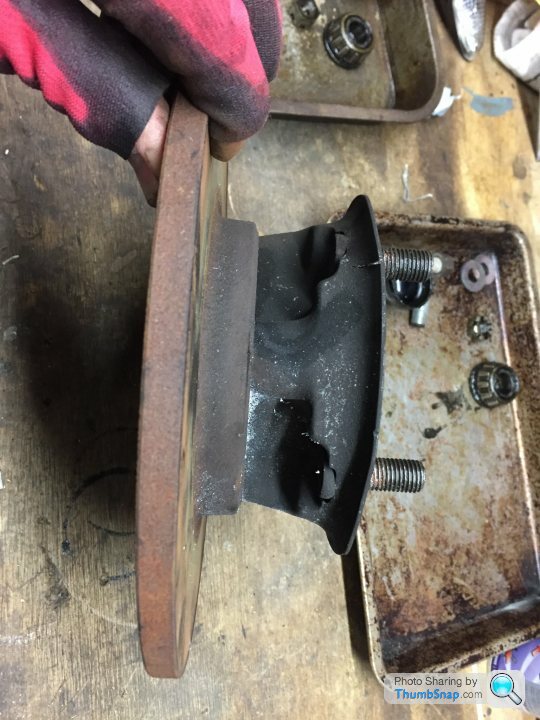 [url]
[url]
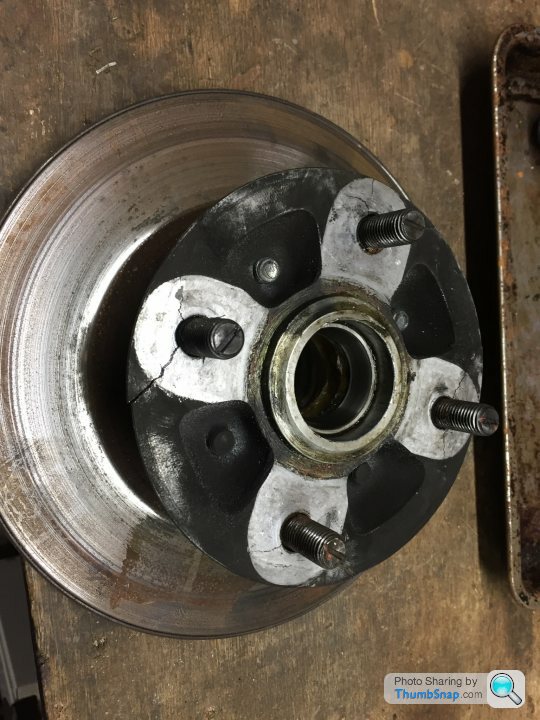 |http://thumbsnap.com/fH1Upkjk[/url][url]
|http://thumbsnap.com/fH1Upkjk[/url][url]
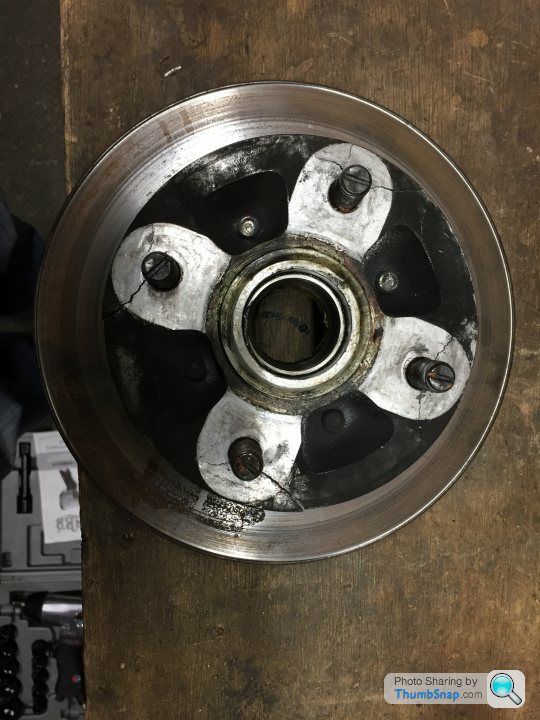 |http://thumbsnap.com/QT3HKdOv[/url]
|http://thumbsnap.com/QT3HKdOv[/url]
Could anyone offer any advice regards getting new 'imperial' hubs?
As you will see from the pictures below, I'm quite lucky!
Any help appreciated, I have ltooked at the Caterham website which looks expensive but also I'm not convinced what they have will fit. If this is the only option then I'll contact them any check etc.
Thanks
Ed
 [url]
[url] |http://thumbsnap.com/fH1Upkjk[/url][url]
|http://thumbsnap.com/fH1Upkjk[/url][url] |http://thumbsnap.com/QT3HKdOv[/url]
|http://thumbsnap.com/QT3HKdOv[/url]Hi,
Wheels were powder coated and for some reason a strange line of powder appeared around the hub area. The wheels would tighten ok but gradually they would come loose so we re torqued them and away we would go. Upon inspection this is what the out come was!
Picture below of one of the wheels.
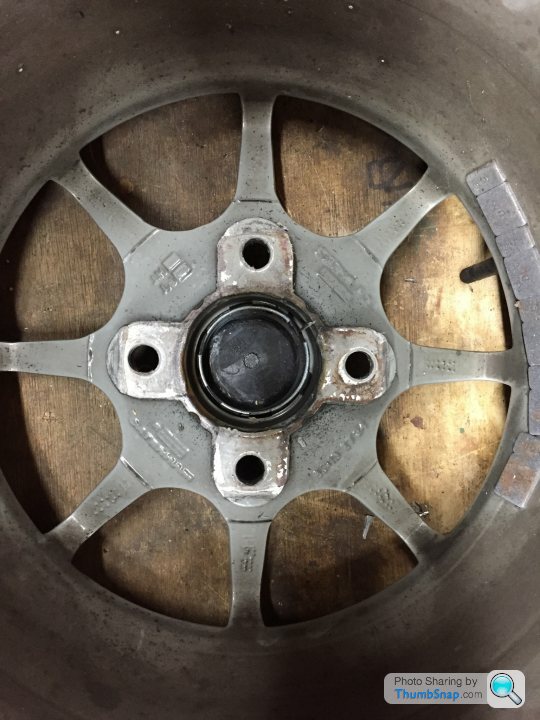
Does anyone have any advice where to buy hubs from? Are they a standard donor fitment, like mk1 escort or something?
Thanks
Ed
Wheels were powder coated and for some reason a strange line of powder appeared around the hub area. The wheels would tighten ok but gradually they would come loose so we re torqued them and away we would go. Upon inspection this is what the out come was!
Picture below of one of the wheels.

Does anyone have any advice where to buy hubs from? Are they a standard donor fitment, like mk1 escort or something?
Thanks
Ed
I think they could be early Caterham and I would replace the lot with their up-grade kit https://caterhamparts.co.uk/hubs-and-bearings/155-...
I suspect that it's a result of over torquing wheel nuts - your description of them working loose is typical of studs stretching after being over tightened.
I suspect that it's a result of over torquing wheel nuts - your description of them working loose is typical of studs stretching after being over tightened.
Edited by DCL on Saturday 25th February 11:11
Pretty certain they're bespoke as they're a Ford PCD but it's a Spitfire stub axle. I think I've got one old one here but TBH you'd be better to upgrade to eh beefed up Caterham parts, they're not that expensive althoguh you'll need to buy new bearings and the axle part of the stub axle
It looks like whoever powder coated the wheels didn't mask the hub face and/ or the wheel nut seats and as you've driven the car the powder coat has worn away and left a gap causing the wheel to become lose
It looks like whoever powder coated the wheels didn't mask the hub face and/ or the wheel nut seats and as you've driven the car the powder coat has worn away and left a gap causing the wheel to become lose
'need to sort those wheels out before replacing the hub that has been trashed because of them!
The build up of paint needs to be removed so that the flange face is flat! (I'd also follow this up with the powder coaters that have cost you a hub or two!)
The Caterham part number you're looking for as sfaulds suggests, is 75113. The photo on the Caterham site looks a little different (the photo looks like one that has been machined from solid, rather than cast, and then machined), but will be dimensionally correct.
Yours are the earlier style that are directly interchangeable with Triumph Spitfire Mk4 parts, but the Spitfire uses 3.75" PCD fixings (as do many live axle cars) where Dedion cars use Ford 4.25" PCD fixings.
Redline or Caterham are the easiest route. Canley Classics may also be able to supply suitable hubs with 4.25" PCD.
http://www.canleyclassics.com/demoapp/?ptno=146479...
The build up of paint needs to be removed so that the flange face is flat! (I'd also follow this up with the powder coaters that have cost you a hub or two!)
The Caterham part number you're looking for as sfaulds suggests, is 75113. The photo on the Caterham site looks a little different (the photo looks like one that has been machined from solid, rather than cast, and then machined), but will be dimensionally correct.
Yours are the earlier style that are directly interchangeable with Triumph Spitfire Mk4 parts, but the Spitfire uses 3.75" PCD fixings (as do many live axle cars) where Dedion cars use Ford 4.25" PCD fixings.
Redline or Caterham are the easiest route. Canley Classics may also be able to supply suitable hubs with 4.25" PCD.
http://www.canleyclassics.com/demoapp/?ptno=146479...
Edited by Red Seven on Saturday 25th February 12:59
Thank you for all the comments, very helpful. I always think how good it is that people take the time to offer advice. One day I'll be knowledgeable enough to offer others something!
The powder coating was done as a favour through a friend etc. So might just put it down as a bad job and get it done elsewhere next time!
The wheels have been cleaned back to bare metal so a good starting point.
What is the benefit of the Caterham upgrade kit? Is it lighter or just stronger?!
I get that about the spitfire hubs etc. I will invest in proper jobbies!
The powder coating was done as a favour through a friend etc. So might just put it down as a bad job and get it done elsewhere next time!
The wheels have been cleaned back to bare metal so a good starting point.
What is the benefit of the Caterham upgrade kit? Is it lighter or just stronger?!
I get that about the spitfire hubs etc. I will invest in proper jobbies!
CTrickle said:
Thank you for all the comments, very helpful. I always think how good it is that people take the time to offer advice. One day I'll be knowledgeable enough to offer others something!
The powder coating was done as a favour through a friend etc. So might just put it down as a bad job and get it done elsewhere next time!
The wheels have been cleaned back to bare metal so a good starting point.
What is the benefit of the Caterham upgrade kit? Is it lighter or just stronger?!
I get that about the spitfire hubs etc. I will invest in proper jobbies!
Much stronger, well the axle part is and the bearings and seals are much better, I had one of the original axle's snap at the upright on a trackday, annoyingly only 30 minutes into the day but fortunately it let go at a slow part. I believe the upgraded design came in as they'd had a number of failures in the race seriesThe powder coating was done as a favour through a friend etc. So might just put it down as a bad job and get it done elsewhere next time!
The wheels have been cleaned back to bare metal so a good starting point.
What is the benefit of the Caterham upgrade kit? Is it lighter or just stronger?!
I get that about the spitfire hubs etc. I will invest in proper jobbies!
Triumph Spitfire
a local motor factors should be able to supply, but I would not be paying any more than £30 for a pair.
http://www.jamespaddock.co.uk/brake-disc-7
or
http://www.canleyclassics.com/triumph-spitfire-mki...
a local motor factors should be able to supply, but I would not be paying any more than £30 for a pair.
http://www.jamespaddock.co.uk/brake-disc-7
or
http://www.canleyclassics.com/triumph-spitfire-mki...
Red Seven said:
Triumph Spitfire
a local motor factors should be able to supply, but I would not be paying any more than £30 for a pair.
http://www.jamespaddock.co.uk/brake-disc-7
or
http://www.canleyclassics.com/triumph-spitfire-mki...
Brilliant, thank you. All sorted!!a local motor factors should be able to supply, but I would not be paying any more than £30 for a pair.
http://www.jamespaddock.co.uk/brake-disc-7
or
http://www.canleyclassics.com/triumph-spitfire-mki...
Canley also do the hub upgrades http://www.canleyclassics.com/uprated-front-hub-an...
I AM ABSOLUTELY HORRIFIED as I’ve only just seen this thread
I was a Lotus senior design engineer.
I happen also to be the person who designed the front hubs for the 7 series 3 & 4 which, to clarify on this thread and for Everyones Information - were specially cast in malleable steel and machined to suit the 4 and a quarter inch pcd of the 5 and a half J series Cortina steel wheels.
Because of the difficulty of making an adequately strong steel hub on the 4 and a quarter inch pcd we also had a serious look at using the series 2 hub at the front and supplying a Triumph/Ford adaptor ring with the spare wheel as a ‘get you home’.
Whoever made the hubs in your picture appears to have used a Triumph or Lotus hub as a master pattern for the casting and screwed?!! the studs into the hub.
Lotus did consider an alloy hub and rejected it due to strength factors caused by brake caliper clearance issues.
The first problem I see structurally on your hub is the shallow depth of material supporting the shank of the stud, which, as mentioned, looks to be threaded with the head recessed into the hub metal. This is another reason why Lotus used steel, as mentioned.
The second big problem is that the type of alloy wheel you have on your car is in my opinion design flawed, to say the least, as it makes no attempt at all to spread the wheel cornering loads evenly across the full face of the hub, but concentrates them at the studs and the design also leaves half of the spokes with no direct load path into the wheel hub - this combination almost certainly caused the localised fretting and eventual fatigue cracking of the hub and in my opinion compromises the wheel integrity long term.
I am sad that you seem to have discovered the worst imaginable combination on your car.
I’m also sorry that this post may seem a bit negative and I can only suggest Triumph 3 & 3quarters PCD steel hubs with reputable wheels of your choice and rear adaptors to point you toward a cheap(ish) solution.
As enthusiasts we all buy our car parts in good faith, assuming what we buy is ‘fit for purpose’
We all eventually pay for bad design, by increased insurance premiums at the best - and with ours and others lives at the worst.
Well chaps, something to discuss here over Sunday lunch! Enjoy!
I was a Lotus senior design engineer.
I happen also to be the person who designed the front hubs for the 7 series 3 & 4 which, to clarify on this thread and for Everyones Information - were specially cast in malleable steel and machined to suit the 4 and a quarter inch pcd of the 5 and a half J series Cortina steel wheels.
Because of the difficulty of making an adequately strong steel hub on the 4 and a quarter inch pcd we also had a serious look at using the series 2 hub at the front and supplying a Triumph/Ford adaptor ring with the spare wheel as a ‘get you home’.
Whoever made the hubs in your picture appears to have used a Triumph or Lotus hub as a master pattern for the casting and screwed?!! the studs into the hub.
Lotus did consider an alloy hub and rejected it due to strength factors caused by brake caliper clearance issues.
The first problem I see structurally on your hub is the shallow depth of material supporting the shank of the stud, which, as mentioned, looks to be threaded with the head recessed into the hub metal. This is another reason why Lotus used steel, as mentioned.
The second big problem is that the type of alloy wheel you have on your car is in my opinion design flawed, to say the least, as it makes no attempt at all to spread the wheel cornering loads evenly across the full face of the hub, but concentrates them at the studs and the design also leaves half of the spokes with no direct load path into the wheel hub - this combination almost certainly caused the localised fretting and eventual fatigue cracking of the hub and in my opinion compromises the wheel integrity long term.
I am sad that you seem to have discovered the worst imaginable combination on your car.
I’m also sorry that this post may seem a bit negative and I can only suggest Triumph 3 & 3quarters PCD steel hubs with reputable wheels of your choice and rear adaptors to point you toward a cheap(ish) solution.
As enthusiasts we all buy our car parts in good faith, assuming what we buy is ‘fit for purpose’
We all eventually pay for bad design, by increased insurance premiums at the best - and with ours and others lives at the worst.
Well chaps, something to discuss here over Sunday lunch! Enjoy!

LuckesGTV6 said:
I AM ABSOLUTELY HORRIFIED as I’ve only just seen this thread
I was a Lotus senior design engineer.
I happen also to be the person who designed the front hubs for the 7 series 3 & 4 which, to clarify on this thread and for Everyones Information - were specially cast in malleable steel and machined to suit the 4 and a quarter inch pcd of the 5 and a half J series Cortina steel wheels.
Because of the difficulty of making an adequately strong steel hub on the 4 and a quarter inch pcd we also had a serious look at using the series 2 hub at the front and supplying a Triumph/Ford adaptor ring with the spare wheel as a ‘get you home’.
Whoever made the hubs in your picture appears to have used a Triumph or Lotus hub as a master pattern for the casting and screwed?!! the studs into the hub.
Lotus did consider an alloy hub and rejected it due to strength factors caused by brake caliper clearance issues.
The first problem I see structurally on your hub is the shallow depth of material supporting the shank of the stud, which, as mentioned, looks to be threaded with the head recessed into the hub metal. This is another reason why Lotus used steel, as mentioned.
The second big problem is that the type of alloy wheel you have on your car is in my opinion design flawed, to say the least, as it makes no attempt at all to spread the wheel cornering loads evenly across the full face of the hub, but concentrates them at the studs and the design also leaves half of the spokes with no direct load path into the wheel hub - this combination almost certainly caused the localised fretting and eventual fatigue cracking of the hub and in my opinion compromises the wheel integrity long term.
I am sad that you seem to have discovered the worst imaginable combination on your car.
I’m also sorry that this post may seem a bit negative and I can only suggest Triumph 3 & 3quarters PCD steel hubs with reputable wheels of your choice and rear adaptors to point you toward a cheap(ish) solution.
As enthusiasts we all buy our car parts in good faith, assuming what we buy is ‘fit for purpose’
We all eventually pay for bad design, by increased insurance premiums at the best - and with ours and others lives at the worst.
Well chaps, something to discuss here over Sunday lunch! Enjoy!
Good morning,I was a Lotus senior design engineer.
I happen also to be the person who designed the front hubs for the 7 series 3 & 4 which, to clarify on this thread and for Everyones Information - were specially cast in malleable steel and machined to suit the 4 and a quarter inch pcd of the 5 and a half J series Cortina steel wheels.
Because of the difficulty of making an adequately strong steel hub on the 4 and a quarter inch pcd we also had a serious look at using the series 2 hub at the front and supplying a Triumph/Ford adaptor ring with the spare wheel as a ‘get you home’.
Whoever made the hubs in your picture appears to have used a Triumph or Lotus hub as a master pattern for the casting and screwed?!! the studs into the hub.
Lotus did consider an alloy hub and rejected it due to strength factors caused by brake caliper clearance issues.
The first problem I see structurally on your hub is the shallow depth of material supporting the shank of the stud, which, as mentioned, looks to be threaded with the head recessed into the hub metal. This is another reason why Lotus used steel, as mentioned.
The second big problem is that the type of alloy wheel you have on your car is in my opinion design flawed, to say the least, as it makes no attempt at all to spread the wheel cornering loads evenly across the full face of the hub, but concentrates them at the studs and the design also leaves half of the spokes with no direct load path into the wheel hub - this combination almost certainly caused the localised fretting and eventual fatigue cracking of the hub and in my opinion compromises the wheel integrity long term.
I am sad that you seem to have discovered the worst imaginable combination on your car.
I’m also sorry that this post may seem a bit negative and I can only suggest Triumph 3 & 3quarters PCD steel hubs with reputable wheels of your choice and rear adaptors to point you toward a cheap(ish) solution.
As enthusiasts we all buy our car parts in good faith, assuming what we buy is ‘fit for purpose’
We all eventually pay for bad design, by increased insurance premiums at the best - and with ours and others lives at the worst.
Well chaps, something to discuss here over Sunday lunch! Enjoy!

Thank you for the reply, intriguing to say the least!
I have now replaced the hubs with upgraded versions. Picture below.
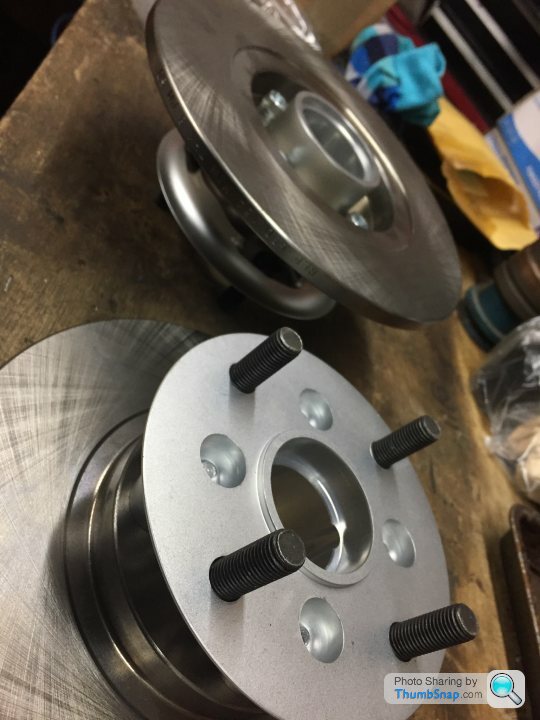
I'm hoping these will be better although I still have the same wheels. The wheels are from an ex Caterham Academy car so are Caterham supplied. In your opinion would you blame the wheels or the hubs more?
Many thanks
Ed.
LuckesGTV6 - I think you are wrong. Only the Herald and Spitfire had steel hubs.
Why did you design a hub when Lotus used an off the shelf Triumph part?
The alloy ones are fine. The hubs in the pictures are the standard Caterham ones fitted from 1973 to recently. There have been tens of thousands of these made and used with no issue. Thousands of those wheels made too.
The only reason the hubs were updated was to provide a larger bearing for the larger stub axle. On race cars, which were frequenting the kerbs, there were a few incidents (not many at all) of the stub axle fracturing. The change to the hub was not related in any way to the wheel fixing.
The casting around the studs breaks if:
1. You try removing the studs with a hammer
2. The wheel nuts are loose.
I've not ever seen steel hubs on a Caterham.
Why did you design a hub when Lotus used an off the shelf Triumph part?
The alloy ones are fine. The hubs in the pictures are the standard Caterham ones fitted from 1973 to recently. There have been tens of thousands of these made and used with no issue. Thousands of those wheels made too.
The only reason the hubs were updated was to provide a larger bearing for the larger stub axle. On race cars, which were frequenting the kerbs, there were a few incidents (not many at all) of the stub axle fracturing. The change to the hub was not related in any way to the wheel fixing.
The casting around the studs breaks if:
1. You try removing the studs with a hammer
2. The wheel nuts are loose.
I've not ever seen steel hubs on a Caterham.
Hi Guys,
I’ll be at Llandow track day on 27th of April which usually has a Caterham 7 or two there and the Club Lotus track day at ‘Combe at the end of May so I’ll have a browse what Caterham are up to these days regarding suspensions and make it my business to chat to the pilots and any of you guys if you are there.
There are still places available at Llandow at about £100 quid for the day and there's usually quite a few Lotus/Caterhams there if anyone is interested - entries close on 27th March.
Now, addressing some of the points you raised:-
I did some private chassis design work for Graham Nearn, early days, when he was thinking about fitting larger capacity engines to the Caterham 7 S4 which obviously used the Lotus four and a half inch p.c.d steel front hubs that I talked about previously.
I’d also be interested to know if the subsequent step back to the traditional style Seven used alloy hubs, I’d suspect they were still steel on the early models at least but I was not involved with Caterham at the time.
To clarify the reason why Lotus had to re-design the front hub on the Series 3 and introduce the larger wheel stud p.c.d. :-
This was due to installing a Ford rear axle.
The change was essential because of an increasing number of warranty claims on the Series 2 axle which lead eventually to expensive mods. to cure the case cracking on the previous type fitted, which used a three and three quarter inch p.c.d., matching the Standard Triumph steel front hubs on this model.
I’m very surprised Ed to read that the wheels you had were sourced through Caterham but I stand by what I posted about their design, and also my comments about the alloy hubs.
Incidentally, to forestall any cynics, I have designed alloy hubs for the Lotus 7X and also road wheels, notably the ones fitted to the Lotus Elite Mk.2 series which were properly fatigue tested and type approved at GKN Sankey, as were both the Dunlop and ‘Brand Lotus’ wheels fitted to the factory Sevens which both featured completely flat machined interfaces to the hub, certainly not with the raised features around the studs in the picture of Ed’s wheel. They look to me a feature that could be easily machined by the manufacturer to change the wheel offset to suit various vehicles. Personally I would call them stress raisers.
Sankey were trying, with Lotus support, to introduce type approval for all UK and imported alloy car wheels because their engineers had found that unsafe products were coming onto the UK marketplace.
I do respect the valid comments you Guys have posted about the 'real world' experiences of both the hub and the wheel in use on your cars – Ed’s problem is possibly a ‘one off’ and my comments have been from a purely design viewpoint but from what I can see of the failure on Ed’s car it does reassure me that we made the correct safety decisions in our hub design at Lotus back in 1967/8.
I’m sorry Ed but I’m not going to speculate from just the photo evidence which of the component(s) or situation(s) caused your hub failure, but in my opinion Caterham should be made aware as they can access the facilities to resolve the cause of failure, As a matter of interest have you checked on the other side of the car for any signs of cracking or fretting ?
Feedback is an important tool for a responsible manufacturer and should be welcomed by them, as Lotus did when we received our regular monthly customer feedback on the Seven from Graham at Caterham Cars when they were a distributor.
I’ll be at Llandow track day on 27th of April which usually has a Caterham 7 or two there and the Club Lotus track day at ‘Combe at the end of May so I’ll have a browse what Caterham are up to these days regarding suspensions and make it my business to chat to the pilots and any of you guys if you are there.
There are still places available at Llandow at about £100 quid for the day and there's usually quite a few Lotus/Caterhams there if anyone is interested - entries close on 27th March.
Now, addressing some of the points you raised:-
I did some private chassis design work for Graham Nearn, early days, when he was thinking about fitting larger capacity engines to the Caterham 7 S4 which obviously used the Lotus four and a half inch p.c.d steel front hubs that I talked about previously.
I’d also be interested to know if the subsequent step back to the traditional style Seven used alloy hubs, I’d suspect they were still steel on the early models at least but I was not involved with Caterham at the time.
To clarify the reason why Lotus had to re-design the front hub on the Series 3 and introduce the larger wheel stud p.c.d. :-
This was due to installing a Ford rear axle.
The change was essential because of an increasing number of warranty claims on the Series 2 axle which lead eventually to expensive mods. to cure the case cracking on the previous type fitted, which used a three and three quarter inch p.c.d., matching the Standard Triumph steel front hubs on this model.
I’m very surprised Ed to read that the wheels you had were sourced through Caterham but I stand by what I posted about their design, and also my comments about the alloy hubs.
Incidentally, to forestall any cynics, I have designed alloy hubs for the Lotus 7X and also road wheels, notably the ones fitted to the Lotus Elite Mk.2 series which were properly fatigue tested and type approved at GKN Sankey, as were both the Dunlop and ‘Brand Lotus’ wheels fitted to the factory Sevens which both featured completely flat machined interfaces to the hub, certainly not with the raised features around the studs in the picture of Ed’s wheel. They look to me a feature that could be easily machined by the manufacturer to change the wheel offset to suit various vehicles. Personally I would call them stress raisers.
Sankey were trying, with Lotus support, to introduce type approval for all UK and imported alloy car wheels because their engineers had found that unsafe products were coming onto the UK marketplace.
I do respect the valid comments you Guys have posted about the 'real world' experiences of both the hub and the wheel in use on your cars – Ed’s problem is possibly a ‘one off’ and my comments have been from a purely design viewpoint but from what I can see of the failure on Ed’s car it does reassure me that we made the correct safety decisions in our hub design at Lotus back in 1967/8.
I’m sorry Ed but I’m not going to speculate from just the photo evidence which of the component(s) or situation(s) caused your hub failure, but in my opinion Caterham should be made aware as they can access the facilities to resolve the cause of failure, As a matter of interest have you checked on the other side of the car for any signs of cracking or fretting ?
Feedback is an important tool for a responsible manufacturer and should be welcomed by them, as Lotus did when we received our regular monthly customer feedback on the Seven from Graham at Caterham Cars when they were a distributor.
So finally getting round to fitting the new hubs and unsurprisingly there are no instructions from Caterham!
I have two spacers both the same diameter as the stub one which is around 6mm and another which is around 2mm, where do they go?!!?
I have called Caterham and unfortunately the parts staff don't know and the service department had gone home, they only work until 4.....
If anyone knows the answer or has photographs of an uprated hub assembly that would be much appreciated.
Thanks
Ed.
I have two spacers both the same diameter as the stub one which is around 6mm and another which is around 2mm, where do they go?!!?
I have called Caterham and unfortunately the parts staff don't know and the service department had gone home, they only work until 4.....
If anyone knows the answer or has photographs of an uprated hub assembly that would be much appreciated.
Thanks
Ed.
Gassing Station | Caterham | Top of Page | What's New | My Stuff



